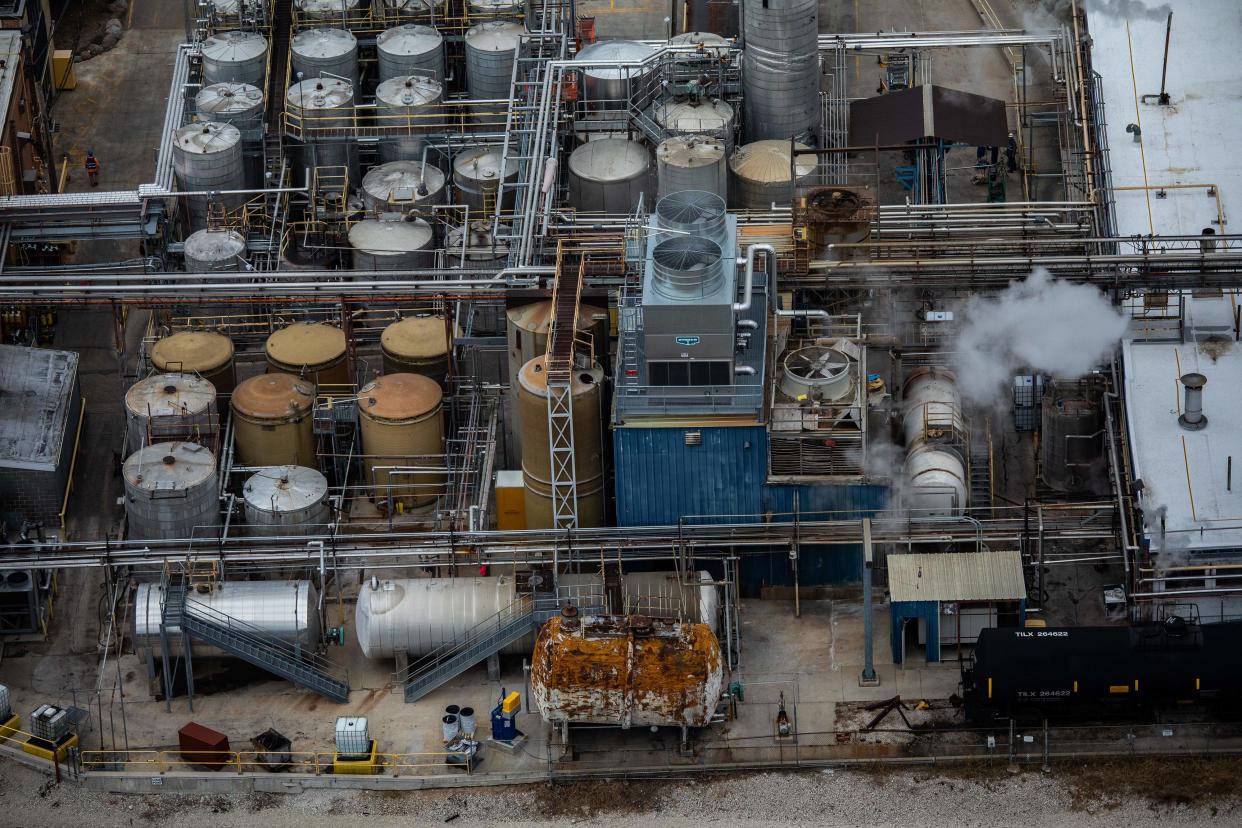Ethylene oxide emissions from 2 plants could have raised cancer risks for Lake County neighbors, report shows

People living near two Lake County industries could face significantly greater risks of developing certain cancers, according to a new federal study based on monitoring of ethylene oxide pollution in surrounding neighborhoods.
Emissions of the highly toxic gas from Vantage Specialty Chemicals in Gurnee were responsible for long-term cancer risks up to 20 times higher than federal guidelines, the report found.
Three miles away, in the southwest corner of Waukegan, the risks posed by Medline Industries’ pollution were up to 10 times greater than 1 cancer case among 10,000 people exposed — the highest rate federal officials consider acceptable.
The study, released Friday by an arm of the U.S. Centers for Disease Control and Prevention, is a snapshot of potential dangers.
Air quality testing near Vantage and Medline during 2019 and 2020 detected spikes of ethylene oxide, also known as EtO, when the wind blew away from the facilities toward homes and apartments. Both companies reported emitting substantially larger quantities of the gas in previous years, suggesting the risks to long-time residents could be even higher than the study estimated.
“It’s unfortunate we will never know much EtO we’ve been exposed to,” said Celeste Flores, a Gurnee resident who grew up in the area and now lives a mile from Medline and about 2 miles from Vantage.
Changes in state law and permitting, prompted in part by Chicago Tribune reporting, required both companies to begin dramatically reducing EtO emissions in 2019.
Medline’s emissions are limited to 150 pounds a year, down from 3,058 pounds in 2014 and 8,638 pounds in 1999. Vantage, which emitted 6,421 pounds of EtO in 2014, is now limited to 110 pounds a year.
More recent monitoring in areas near Medline show EtO concentrations in the air are declining but there are still lingering cancer risks for close neighbors, the study found. The Agency for Toxic Substances and Disease Registry said it could not determine the current risk for people living near Vantage because monitoring near the plant ended in May 2020. More testing is recommended.
Vantage did not respond to a request for comment. A Medline spokeswoman declined to comment until the company’s executives review the findings.
Four years in the making, the federal study is the latest documentation of health hazards that chemical manufacturers and sterilization companies have spent decades attempting to downplay, if not outright deny exist.
The first study detailing how EtO causes genetic mutations was published in 1948. During the 1970s, animal studies confirmed its powerful ability to scramble DNA could trigger cancers.
After two rounds of independent peer review, the U.S. Environmental Protection Agency declared in 2016 there is essentially no safe level of exposure to the toxic gas.
EPA researchers relied in part on a study of more than 18,000 workers at sterilization plants similar to the one operated by Medline in Waukegan. The worker study linked ethylene oxide exposure to breast cancer, leukemia and lymphomas.
In their conclusions about the latest research, federal officials cautioned it is impossible to connect inhaling EtO to individual cancers in Lake County given the normal risks everyone faces. But the chemical is so potent it could take as little as a year of exposure to industrial emissions to increase long-term cancer risks, the study concluded.
About 7,000 people live within a mile of Vantage. Another 6,000 live that close to Medline.
Anyone concerned about health damages should consult their physician, said the ATSDR, which has published an online briefing to help guide diagnosis and treatment. The agency will host a public forum from 5-8 p.m. Wednesday at Cristo Rey St. Martin College Prep, 3106 Belvidere Road, Waukegan.
Federal health officials said limited and intermittent air quality testing in 2019 and 2020 prevented them from determining if EtO emissions from Vantage and Medline posed health risks farther away from the facilities.
By contrast, EPA officials said in 2019 that ethylene oxide pollution from the now-closed Sterigenics sterilization plant in west suburban Willowbrook increased the risk of developing cancer for people living as far as 25 miles away.
The findings prompted neighbors and elected officials to demand that Sterigenics leave town, which it eventually did.
A different type of intervention prevented other communities from getting the same treatment.
On multiple occasions, the EPA’s inspector general reported in 2021, former President Donald Trump’s appointees in Washington ordered the agency’s Chicago office to dramatically scale back efforts to understand the dangers of ethylene oxide in the Midwest, including in Gurnee and Waukegan.
Flores and other Lake County activists couldn’t help but notice other differences between the two situations.
Neighbors of the shuttered Willowbrook plant are predominantly white and upper-middle class, while neighborhoods near the Gurnee and Waukegan facilities include larger numbers of Latino and Black residents with lower median incomes.
“I’m glad this study is finally out so we can help educate the community,” Flores said. “But it shouldn’t have taken this long.”

